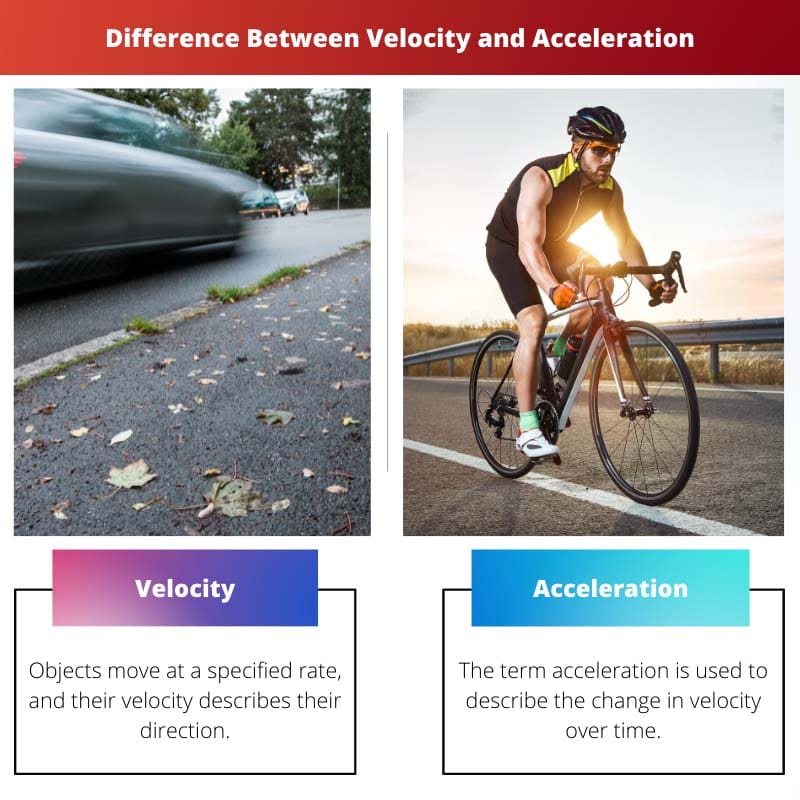Velocity and Acceleration are both different concepts used while discussing motion. Hence, they are both related to motion.
Speed is used to define one term, while the other is based on a change in velocity. Both have a lot of similarities and are also used for the same purpose.
However, their meaning is significantly different and is used to determine primarily different things.
Key Takeaways
- Velocity is the rate of change of displacement concerning time, while the acceleration is the rate of change of velocity concerning time.
- Velocity is a vector quantity with both magnitude and direction, while the acceleration is also a vector quantity and points in the direction of the change in velocity.
- The SI unit of velocity is meters per second (m/s), while the SI unit of acceleration is squared (m/s^2).
Velocity vs Acceleration
Velocity is the rate at which an object changes its position with respect to time. It is a vector quantity that includes both magnitude and direction. Acceleration is the rate at which an object’s velocity changes with respect to time. It is also a vector quantity with magnitude and direction.

Objects move at a specified rate, and their velocity describes their direction. This defines the rate at which someone or something changes position concerning time or the speed of a moving object from one location to the other.
Meters per second (m/s), kilometres per hour (kph), and miles per hour (mph) are the units used to measure velocity.
The term acceleration is used to describe the change in velocity over time. In addition to its magnitude, it also includes its direction in a vector expression.
A moving object’s speed or direction can increase or decrease when the object accelerates. It shows how the body’s motion changes over time.
Comparison Table
| Parameters of Comparison | Velocity | Acceleration |
|---|---|---|
| Unit | Metre per second is the measuring unit. | Meter/second 2 (m/s2) is the measuring unit. |
| Calculation | Displacement is used to calculate. | Velocity is used to calculate. |
| Ascertains | In which direction and at what speed an object is moving. | Change in velocity overtime of a moving object. |
| Motion | Negative, positive or zero. | Negative or positive. Cannot be zero. |
| Meaning | The term velocity is used to describe the speed of an object in a given direction. | When an object changes its velocity concerning time, it is Acceleration. |
What is Velocity?
Objects move at a specified rate, and their velocity describes their direction. This defines the rate at which someone or something changes position concerning time or the speed of a moving object from one location to the other.
Hence, it is the displacement of the object divided by the displacement time. It can be negative, positive or zero.
Meters per second (m/s), kilometres per hour (kph), and miles per hour (mph) are the units used to measure velocity.
The two possible velocity values are an object’s average velocity (the calculation of its velocity throughout a period) and its instantaneous velocity (its velocity at a specific moment in time).
In which direction and at what speed an object is moving is what is ascertained by the concept.
Tissue Tracking Echocardiography (TTE) is primarily about tracking a point or region of interest. Generally, velocity refers to the speed at which the myocardium moves.
During systole, the myocardium travels towards the apex at positive speeds. The diastolic velocities of the heart are negative during diastole. A myocardial segment’s displacement is how far it moves from its initial position.
The unit of fetal echocardiography is millimetres and is indicated positively.
What is Acceleration?
The term acceleration is used to describe the change in velocity over time. In addition to its magnitude, it also includes its direction in a vector expression.
Its Components, such as direction, indicate the object’s speed and direction change. It can be negative or positive. However, it can never be zero since should always be some movement for it.
Meter/second 2 (m/s2) is the unit used to measure it. It is believed that an object is accelerating or its speed increases when the acceleration is parallel to the velocity.
Conversely, the object decelerates or slows down when acceleration is anti-parallel to velocity. Additionally, the component of acceleration that is parallel to velocity indicates how much the object’s direction has changed.
There are two types of acceleration, namely, Centripetal and Tangential. A uniform speed in a circular motion, such as the rotation of the earth, is referred to as centripetal acceleration because the object’s direction changes.
On the other hand, Tangential acceleration occurs when the direction does not change, but the speed does. The concept ascertains the change in velocity over time of a moving object.

Main Differences Between Velocity and Acceleration
- The term Velocity is significantly put into use to describe the speed of an object in a given direction. On the other hand, the term Acceleration is put substantially into use to describe the change in velocity over time.
- The former is determined using displacement. On the other hand, the latter is determined using velocity.
- Negative, positive or zero is what velocity can be. On the other hand, negative or positive can be used to indicate acceleration. However, it can never be zero.
- The formula used to calculate the former is displacement object divided by the displacement time. On the other hand, the formula used to calculate the latter is by dividing the change in the velocity by the time in which the change has taken place.
- The velocity is used to ascertain in which direction and at what speed an object is moving. On the other hand, acceleration is primarily used to ascertain a moving object’s change in velocity over time.




